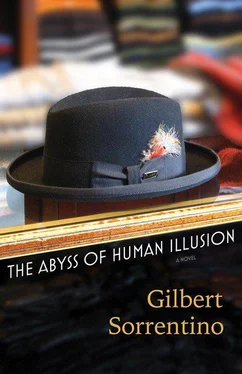On the following day he would wear long underwear, put a few sheets of newspaper between two sweaters, and don a scarf, the cap that Al had given him, heavy gloves, and two pairs of socks under his old low quarters. He would be a worker instead of a chump, sad in his chump’s ignorance.
On the evening of that first bleak and bitter day, when he took himself home, a core of terrible ice sat solid inside his body; all the way home on the subway, the bus, the three-block walk to the small apartment that he and his wife were slowly fading away in, he shook with the cold. A glass of straight bourbon couldn’t get him warm, nor could the spaghetti, of which he had seconds and then thirds. It did nothing. He trembled and shook at the table and while he watched television and, undressing for bed, shook even more fiercely as the cool air of the bedroom touched his bare flesh. And then he realized that this was the sign, this frozen center of his body, his pitiful, stupid body was her body, too: they were both dead or dying. His wife asked him, for the first time, what the matter was. She smiled as if vaguely annoyed by the intolerable ague that possessed him. Are you sick? she asked. Oh yes, he was indeed.
He was a third-rate painter, who believed, because he had started painting as a ten-year-old in England, that he had been born a kind of prodigy, of the sort that simply could not blossom in the United States. When he came to America at fifteen, with his mother and father, he was enrolled in public high school, where his meager talents impressed his teachers, whose knowledge of painting had been gleaned from worn postcards from the Met and Modern, the Art Institute of Chicago, the Frick, and so on. They knew that their pupil was — what was he? — he was far more talented and knowledgeable than anyone else in their classes or in the school, for that matter. All this praise and blather enforced his fantastic conception of himself. So his adolescence and young manhood passed, and at twenty-two or so he was turning out canvases that were banal parodies of de Kooning. In this, it must be said, he was not alone. He was quite insufferable in every way, suffused, as he was, with monstrous illusions of his restless and iconoclastic genius, although one had to know him for a time before these aberrations showed themselves plain.
It so happened that he met a beautiful and funny and intelligent girl at one of the scores of parties that tended to erupt, acne-like, in the downtown “scene” of the mid-fifties, those carnival days. To the astonishment of everyone, he and this girl began an affair, and, six months later, married. It seemed clear that she married him because of what she took to be his genius and because of her devotion to this genius; and he married her because she — only properly — flattered him and, well, she was beautiful. “See?” he seemed to say to his peers, all of them peering out enviously from behind their inert versions of “Bill” and “Franz” and “Jackson.” She was, as noted, intelligent and educated, but basically ignorant of art when she married the whiz. But. Ah, but.
But her marriage to him brought her, quite naturally, into contact with many artists on an almost daily basis — dinners, shows, openings, parties, weekends in the Hamptons before the sands had turned to gold dust, raucous and drunken Provincetown softball games, and so on. And these painters, as well as their wives and lovers, said enough, usually obliquely and glancingly, but enough, to let her know that they thought of her man as, well, not much of an artist, and a bit of a bore. Even more damaging to the connubial partnership, she began to: 1) see the work of good, sometimes very good, painters who were her husband’s peers; and 2) develop a critical eye, a set of aesthetic measures, a way of thinking about painting that was independent of her husband’s essentially envy-tainted remarks. And so she began to see clearly his work, and to battle with herself over what she thought to be her growing, silent betrayal of him. But he was, well, he was, really, not very good. Not very good at all.
Slowly, softly, and as they say, as quietly as the famous little cloud no bigger than a man’s hand, she began to think of him differently and then to treat him differently; she moved from a kind of genial tolerance to vague patronizing denigrations to blunt contempt. After two years, she left him. He continued to paint, of course, but his anger and unhappiness did nothing for his work, which, in point of fact, got worse. This was the period in which he did a series of what he called “Suburb” paintings, about which even his friends were uncomfortably silent. Some of these daubs were hung on the walls of new restaurants in the newly named SoHo; later, he moved to England, where his career foundered and collapsed.
TO THE EDITOR:
Sheldon Dufoy’s letter to last week’s “Faith Base” section was in very poor taste and lacking of good sense and education in the Christian religion field. The Bible tells all Christians who are true Christians that there is no way of entering Heaven unless you are born again and accepting Jesus Christ in your heart as the only true Lord of the Universe, be it vast or otherwise, it does not matter for the Lord God is all Supreme.
There is no other god or gods, and Mohammed (or Allah), Moses, Talmud, Buddha, Zen, Hindu Deity, and others, for instance, of the Eskimos, Africans, Bushmen, Pygmies, and so on are, are all false gods that lead nowhere but to everlasting torture in the fiery flames of Hell forever in eternity, Mr. Dufoy’s secular humanistic beliefs and fashionable liberal ideas are not based on the Holy Bible, which alone, he might not be aware of, is the Word of God.
As for the translation of God’s word maybe being not accurate and so, therefore, not the true Word of God, as was spoken by Him or Jesus Christ, his son, Mr. Dufoy should know, to lighten up his ignorance, that the Almighty God or Jesus sometimes was at the side of King James and his helpers as they labored, in spirit and giving them strength in their labors. It is almost amusing to read such displays of ignorance however, but I hope that Mr. Dufoy soon asks God into his heart, for Jesus, is always standing by miraculously every single person at the same time, waiting for such an invitation, even though it may be given by a Jewish person, despite what they have done to Him over the thousands of years ever since Adam and Eve. He forgives even them and their crucifixion of Him, hard though it is for, He is the lord of forgiveness and a great Boss, no matter how small it may seem or unimportant.
This letter was found in the desk drawer of its author some few weeks after a massive stroke led to his death outside the Pinto movie theater, which establishment he had just exited. The film playing at the time was Hot Bottoms, starring J’Adore Vegas. The letter was tucked into an addressed, stamped, but not sealed envelope. In another drawer of the same desk there was discovered some 1,500 pages of pornographic writings by the same author, rife with solecisms, tattered grammar, bad spelling, and a syntax seemingly borrowed from a lost language.
Notable in this work of erotica — apparently a series of linked amorous adventures — is the presence of a recurring female character, a “quivering,” “shameless,” “tremballing,” “moaning,” “large-breasted,” and “full-lipsed” young woman, who, the patient reader is told, over and over again, looks exactly like Julia Roberts, and who often has “depraved” and “perverted” sex with other women, all of whom bear the name of the deceased author’s wife, Myrna.
When told of the discovery of this venereal cache, Myrna unhesitatingly averred that Satan was certainly the author of such filthy material, for her husband — and, as his wife, she could, she said, testify to this — knew absolutely nothing about sex. “I could tell you some stories,” she remarked, and then fell silent.
Читать дальше












